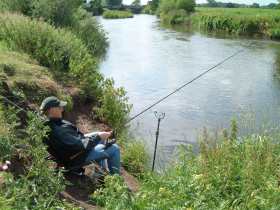|
|
| |
Dave will use heavy gear to fish for big barbel one day and a pole on ultra-light tackle the next to bag up on roach.
The emphasis on this series is how to enjoy your fishing no matter where you’re fishing or what you’re fishing for.
The Barbel Buzz
The river season is in full swing again and I just cannot wait toget down on the bank for those after-work sessions or for a few hoursat the weekend. I like to fish almost anywhere, but there issomething about rivers and running water that calls me back timeafter time. And I have become somewhat addicted to the buzz ofhunting barbel on those long evenings where you are able to stay onthe bank in daylight for a few hours after teatime and thenexperience those magical moments around dusk where you anticipate thebarbel really coming out to play in earnest.
|
|
| |
Now I don’t really care how big a barbel is so long as I catch oneor two, so I rarely set my stall out to catch a monster. I am quitehappy catching ‘shoalies’, barbel that run not much bigger than sevenpounds or so, as they put up a quite astounding scrap for their size. This, I think, is the type of fishing that is available to the’average’ barbel angler. The fact is we don’t all have access to bigfish or, most often, don’t have the time available to put in thehours required to sort out that elusive big one.
Best barbel fishing is at the end of the day
My fishing is mostly limited to evenings with the addition of theodd day off work. But I don’t mind that, especially for barbel,because nine times out of ten the best barbel fishing to be had is atthe end of the day anyway. So my tactics are geared to getting ashoal of fish feeding in as short a space of time as possible andcatching as many as possible in the few hours available to me. Venues are usually the Severn, Teme or Bristol Avon.
Paternoster preference and flavoured casters
The method is usually the same, utilising a good simple feederrig. Contrary to some I like to fish my feeder on a paternoster rig,rather than a sliding feeder rig, especially when using a longhooklength. More about how long the hooklength should be later. It’s merely a preference, but I feel the paternoster rig is moresensitive to that first pluck at the bait that normally occurs just amicrosecond ahead of the tip slamming over. It’s not much warningbut at least you are semi prepared.
|
|
| |
Bait for a barbel session is most often caster and hemp, using twoor three casters on the hook. Sometimes I add some flavouring to thewater that I keep the casters in, such as one of Archie Braddock’sliquid flavours. Then it’s just a case of getting them feeding. IfI was to be asked what I thought the most important aspect of barbelfishing was I would have to say bait quantity. The most commonmistake in barbel fishing is not using enough bait and not feeding itoften enough. I might get shot for this remark, but shoal barbel arevery much like carp in this aspect. Generally you cannot give themtoo much feed. If you introduce enough feed often enough you can attimes get them climbing up your rod. If you fail to feed them theywill lose interest and slip away or get easily spooked when you hookone from the shoal.
Feed first – fish later
And therein lies another trick. Although I am fishing for only afew hours, I try not to be in too much of a rush to catch the firstfish. It often pays to spend around the first 20 minutes to half anhour constantly casting the feeder packed with hemp and casterwithout a hooklength. In some swims it is possible to feed by hand orcatapult, or bait dropper, which is a bit faster. Get some bait down,draw a shoal of fish in and get them feeding confidently.
If you hook a barbel from a shoal before they are engrossed on thefeed you can spook them almost before you have started. Another tipis to not be too worried about spreading the feed a bit, withinreason of course. If all the bait is in a two square foot area nomore than a few fish will be able to feed at a time. Don’t be afraidto give the barbel a large dinner table with plenty of bait and getas many fish searching around as possible, hoovering up the particlesof feed. Believe me, they will find your bait. Quite often yourquiver tip will plink and bounce as the barbel catch their fins onyour line as they move over the feed area, adding to the expectationof the bite arriving.
When a good bed of bait is down, tie on the hooklength and startfishing. If you have picked the right swim barbel will be drawn tothe feed and a bite can often come almost straight away. Even if youdon’t get an immediate bite, keep loading and casting the feederevery two or three minutes. Don’t be tempted to stop feeding untilthe first bite has occurred. It doesn’t take long for a barbel shoalto clear the contents of 50 or so feeder loads of bait when they doarrive.
Hooklength length
I mentioned earlier about how long a hooklength should be. Igenerally start by using a hooklength of around 2 ft though you mayneed to go longer if the fish are a bit shy of the feeder. Butsometimes the barbel are known to throw caution to the current andthey feed with such abandon that they attack the feeder as soon as ithits the water. This happens quite often on the Severn.
If you are lucky enough to encounter this phenomenon it is worthshortening the hooklength to just a few inches and fishing the feederin line, giving the barbel far more chance of picking up yourhookbait close to the feeder. If you can, set up two rods, one withthe long paternoster rig and one with the ‘short’ in line rig, so youcan switch quickly between the two. After a few fish on the shortrig the barbel may become ‘feeder shy’, so be prepared to switch backto the longer rig if takes dry up, maybe even removing the hooklengthand making a few casts with just the feeder to bring their confidencelevel back up.
Hold the rod
Another thing I do, though it’s not strictly necessary, is holdthe rod and I don’t put it in a rest unless I have to. I getcomfortable in my chair, which is set so I am leaning back slightly,and hold the rod so it is balanced with the reel resting on my kneeand my index finger hooked over the line.
|
|
| and hold the rod |
Last gasp tactic
The above, I know, is ‘perfect world’ and you are not going to getevery session running entirely to plan. Sometimes, for whateverreason, the barbel just won’t play ball and, despite constantfeeding, the fish just don’t appear or you get one bite and thennothing. But there is a last ‘gasp’ tactic you can try in this eventthat has worked for me on occasions, saving me taking my landing nethome dry.
|
|
| |
As the last half hour of your session approaches and you haveabout given up hope of even a single barbel, take off the feeder andput a straight lead in its place, change the hook for a size 4 andget the meat out. Hook up a large piece of meat and launch it intowhere your hemp and caster have gone all session and leave it. Justsometimes, when the feeder has stopped it’s constant splashing intothe swim, a cautious barbel will move over the feed, pick up that biglump of meat and just rip your rod tip round.
The buzz to be had
And that is ultimately what barbel fishing is all about, gettingyour rod tip wrenched round. When it all goes right and the barbelare in your swim and the tip is bouncing with the line bites and youare totally focused on your rod top and the adrenaline is flowingwith anticipation. There is nothing quite like it.
When the rod tip is violently pulled round and you strike into awhirling dervish that is trying to convince you it is at least threetimes its actual size, fighting every inch of the way into the netyou wonder: who needs drugs when there is a buzz like this to be hadbarbel fishing?















